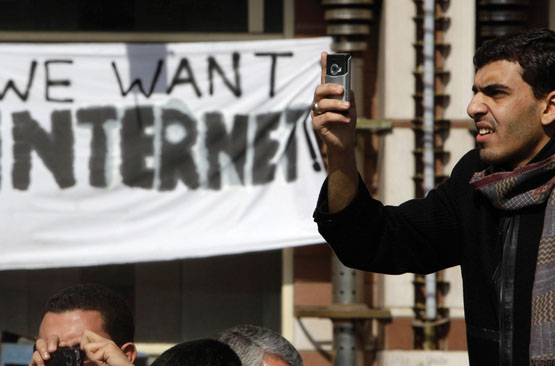Revolutions of the Imagination

What is happening in the Arab world is not simply a series of revolutions against the tired ideologies of oppressive states—although it is that, too. The uprisings are the physical traces of a much more profound transformation: a rearticulation of what it means to be a person in the world. I call this a revolution of the imagination. But what does this have to do with Vassar students?
Using tried-and-true methods of evaluating importance—roughly whatever is culturally or geographically closer to “us”—the tumults in the Arab world have very little to do with Vassar students. What has been dubbed in our media the “Arab Spring” might well have bearing upon those studying the region or be of passing interest to those who like to cheer for the underdog. But how could the uprisings be relevant to students taking their breakfast at the Retreat? This cultural turbulence is taking place in an unintelligible language, on unknown streets, against alien systems of governance, half a world away. Vassar students have other things to worry about: Will they have enough money to go somewhere this summer? Can they afford another unpaid internship? And how are they going to find a job in this dreadful economy?
But maybe it’s not Vassar students who have changed their relationship to what’s happening in the world. Maybe it’s the world that has changed its relationship to Vassar students. The tried and true measurements—time and space—are themselves transformed. Fundamental concepts of distance and proximity, of “here” and “there,” “global” and “local,” have ceased to give our lives the kind of meaning they used to. The binaries that seemed to help define us as American and not something else—us/them, Western/Eastern, Judeo-Christian/Muslim, First World/Third World—have lost their luster. We can no longer divide the globe up into hermetically sealed geographic regions and talk about them separately.
It is no secret that new communication technologies have changed the way we interact with one another. China once seemed as far away—geographically and culturally—as the moon. Now a Vassar student born in Flushing, Queens, can instantly see and talk to her cousin in Beijing. The time and distance between New York and China have been reduced, at least for that exchange of information, to zero. The two young people are, for that instant, in the same space and in the same time. In this moment, it is impossible to say that China is there and the U.S. is here.
But these communication technologies have done more than change our interaction with one another. They have contributed to widespread changes in our very nature. The way humans interact with the material world has been radically transformed from the way we interacted during my childhood in the 1970s. Children coming to consciousness at that time would have found their developing identities impacted by interactions with their proximate world: parents, school and books, church/synagogue/mosque/temple, interaction with governmental and military bureaucracies, the movie theater, and the five or six television channels that existed at the time. Although television did increasingly bring the outside world in—in a more immediate way than books and newspapers—much of our perception of the world still involved having to physically interact with it.
In Egypt (where my father’s family is from), Syria, and other Arab countries, the kinds of inputs that went into constructing an identity—school, mosques and churches, military service—were closely controlled by the national state. Television and film underwent a similar kind of censorship as they did here in the U.S.—for sex and violence—but also a kind of direct political censorship that we didn’t have here. The ways Arabs and Americans could imagine themselves in relation to the wider world in the 1970s and ’80s were, in effect, limited. Egyptian society produced Egyptians; American society produced Americans. The world seemed to make sense.
This was a world in which imagination was an escape from the “real” world, where an American boy could imagine himself flying above ancient Middle Eastern minarets on a magic carpet or an Egyptian girl could imagine herself standing in front of the Statue of Liberty or the Eiffel Tower in order to escape the drudgery of her material life.

But the role of imagination has been transformed. We live in a world in which the film Avatar cost more than $100 million dollars to create. Most Americans have instant access to 200 or 300 television channels. Billions of dollars, pounds, dinars, and yuan are spent, and millions of people are employed, all in the service of trying to figure out precisely how to stoke the imaginations of global audiences. Imagination is no longer an escape from the real world but has become very much a part of the real world economy. Imagination, in other words, has moved to the center of our contemporary reality. Nowhere was this more evident than when Israeli film reviews of Avatar cast their society as the underdog Navi or a group of Palestinian children painted themselves “Navi blue” in protest against the wall Israel is building across the West Bank. Reality and imagination had thus blended into one as each group imagined itself in the color of the oppressed.
And this is what I mean by a revolution of the imagination. The way that people see themselves in relation to the rest of the world is no longer restricted by the bounds of their proximate material reality. Egyptians, Syrians, and Tunisians did not simply take to the streets spontaneously. Instead, a new conception of the individual’s relationship to society has been taking hold of people in the region for the last two decades. The blooming of satellite television channels like Al Jazeera and Al Arabiya, two of approximately 400 television channels that Arabs can now watch, has led to political discussions and criticisms that were unimaginable on the one or two channels of state television to which people once had access. It’s not the kinds of ideologies about which people are arguing that are new, it is the fact that people are publically arguing instead of silently bowing to the will of their corrupt governments.
But even more immediate, the increasingly widespread use of the global Internet in the Arab world has led to a profound restating of the relationship between the individual and society. In traditional Arab society—Muslim and Christian—the basic unit of social importance has long been the family, not the individual. In using Facebook or Twitter, though, each individual becomes the star of his or her own narrative. It’s not simply that Facebook and Twitter were used to organize protests in Cairo, it’s that their continued use creates imagined webs of relationships in which the individual crafts his or her own identity and is constantly at the center of his or her own story. By losing audiences to transnational satellite, by letting literate citizens escape into the world of imagination on the Internet, Arab national states have lost control over crafting their perfect citizens. Young people have slipped through the hands of their ineffective governments and are now interacting with the rest of the world on their own terms.
The very conditions, then, that have enabled young Arabs to say no to their governments also weaken cultural binaries between “here” and “there.” Today’s Vassar students were born in the early 1990s around the beginning of the global Internet. Unlike previous generations, their entire existence has been mediated by electronic communication. The economic, political, social, and cultural linkages between Americans and the rest of the world are no longer dependent upon external forces like business or government but are in the hands of each of us.
It is in this context that a group of Vassar students spent the fall semester investigating the “Arab Spring.” In the Film and Media Studies class “The Middle East in Cinema and Media,” which I taught, we looked at the relationship between Arabs’ use of television, film, and the Internet, and the uprisings that are taking place. Built around the idea that this revolution of the imagination has been enabled by changes in the production, distribution, and consumption of media, the class encouraged students to question the similarities and differences between themselves and the Arabs (and other Middle Easterners). And, importantly, to do so in a non-confrontational way. In watching films produced in and about the Middle East and reading academic writing on the region, the class asked the students: What can we learn about ourselves from studying what’s happening in the rest of the world? What is our relationship to the new mediated world? What is our relationship to failing politics based on the old way of doing things? What is our responsibility to the future?

Tarik Ahmed Elseewi is an Andrew Mellon Postdoctoral Fellow in Television Studies at Vassar. This past fall, he taught the Film and Media Studies course “The Middle East in Cinema and Media.” He completed his Ph.D. on the subject of media and national identity in the Arab world at the University of Texas at Austin.
